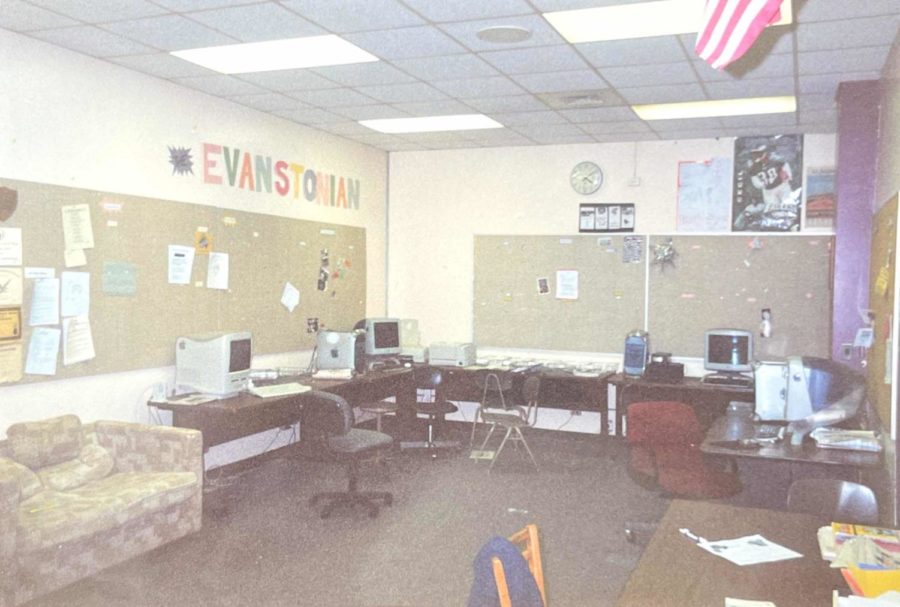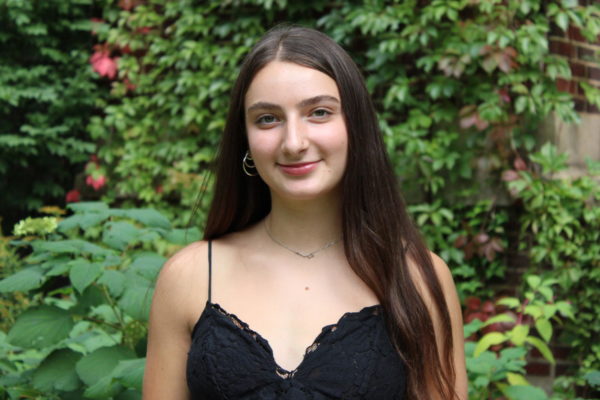Execs through the decades
March 15, 2023
The Evanstonian office is situated at the intersection of the South Wing and H-Hall on the first floor of the building. At any given time, S103–the Evanstonian’s layout room–is lively and spirited. The door remains cracked during the school day, empowering contributors to come in and out as they wish.
During layout, nearly every seat is occupied by members of the Editorial Board. The staff’s eclectic music taste makes for a diverse collection of songs that closely mimic the multifaceted makeup of the publication. Accompanied by the sound of squeaking office chairs and typing on computer keys, the music is nearly muffled by people’s voices as they eagerly converse. At the rear of the office, one member–with a piece of paper and pen in hand–collects everyone’s Tomate order: a Friday night staple. Some make final edits, while others transcend the text onto the digital software. Everyone, regardless of their distinguished role, is driven to see its journey from conception to a finished product.
At the heart of the Evanstonian are the Executive Editors. Responsible for developing and leading the vision of the publication, these individuals facilitate a community of journalists, artists, photographers and designers. Throughout the years, even as the world has undergone dramatic transformations, the mission of the paper has stayed consistent: to reflect the timely issues, experiences and conflicts that affect the student body and school community at-large.
A decade ago, Yoni Hirsh, Ellen Schneider and Jessica Baum emerged as the Executive Editors for the 2012-13 school year. On the final day of their junior year of high school, the three hovered beneath the paper on the door, where the subsequent Executive Editors were listed. Hirsh, Schneider, and Baum pride themselves in knowing that together, they nurtured a “family” within the greater Evanstonian community.
For Hirsh, reminiscing on his evolution–from an intimidated staff writer to one of the most influential figures on the paper–is an extremely meaningful venture.
“When I first started [writing for the Evanstonian], I enjoyed writing but had never [written] any journalistic pieces before. The first two or three issues we had, I worked really hard on my stories, and even though I submitted them, I wasn’t published. And when I look back, it was because the stories themselves weren’t great. I needed to really hone my craft and get better at my writing and the way that I structured my pieces,” Hirsh shares. “Eventually, my stories were being published weekly, and I became an Executive Editor. That was definitely a formative moment, realizing that I wasn’t great at something and deciding to put in the time and effort to get better at it. In the end, the results paid off.”
Hattie Stahl dove into the newspaper her freshman year and never looked back. In 2003, she stepped into her role as Executive Editor, alongside her co-Executive Editor, Ravi Randhava. Having seen the power of journalism from a young age, Stahl makes informed decisions about the voices she absorbs today.
“As an Executive Editor, I had to recognize what voices weren’t being given a platform. So much weight is given to published word, and the responsibility that comes along with it is really special but with that privilege, there’s a lot of power,” Stahl shares. “Being aware of what wasn’t being told was huge.”
At a school the size of ETHS, it is not uncommon for students to feel alienated. Carrie DeYoung, one of the Evanstonian’s Executive Editors in 2000, felt a responsibility to provide a voice to the voiceless through her coverage.
“As a student, you only see a fraction of what’s going on, but the Evanstonian gave me a way of storytelling and highlighting all of the unique things that were going on at ETHS and [within] the [local] community,” DeYoung says.
Many would argue that editorials are the heart and soul of the newspaper; they intend to promote public consciousness to timely issues and inspire readers to internalize critical subjects. For Baum, having the ability to guide these narratives was a powerful and stimulating experience; it not only heightened her personal confidence but also enabled the staff to get in touch with their inner voices. Baum and her fellow Executive Editors consistently tried to write editorials that were capable of evoking change within the local community.
“I was someone who always tried to push the button in terms of what editorials we wrote. There are easy editorials, but some editorials can actually change the policy, and that happened a couple of times when I was on staff.” Baum continues, “What you write does matter, and you can make a change through your coverage.”
In many ways, by being student-led, the Evanstonian offers the most accurate depictions of the trials and tribulations of the local community. Suddenly, stories don’t just involve strangers–they feature the experiences of classmates or friends.
“The most meaningful work I did with the Evanstonian was during my senior year,” Hirsh shares. “We were getting ready to publish an issue, but we were kind of blindsided by the passing of Dajae Coleman.” On Sept. 22, 2012, Coleman, “an inspiring leader, basketball star and trailblazer,” as cited in a Medill Report, fell victim to gun violence at just 14-years-old. “It was a devastating moment for the school, and we needed to cover it in our paper. We didn’t have a lot of time left, so I took it upon myself to write that story. It was really hard in the logistical sense, trying to get everything together in a week. But more importantly, talking to family and friends of Dajae right at that sensitive time was really tough. It was a meaningful story that I was thankful to be a part of and share a little bit of Dajae’s story with the community.”
Taking the time to share these stories–the heavy and sensitive ones–isn’t effortless, however it can be a fulfilling endeavor for the writer and community alike.
“I will forever remember the feeling I had the day the paper came out. I would walk through the halls and see everyone behind their copies of the Evanstonian. It was just such a rewarding experience to see what the Evanstonian staff had worked on and then, suddenly, there it was, and everyone was reading the newspaper and talking about it,” says Dan Newberger, one of the Evanstonian’s Executive Editors during the 1991-92 school year.
Since the 1988 Hazelwood School District v. Kuhlmeier decision, administrators have had the ability to regulate student speech if it is inconsistent with the schools’ educational mission. The Evanstonian is no exception to this legal reality. As a high school publication, the Evanstonian continues to monitor and conform its boundaries. However, compared to the censorship that transpires across the nation, the relationship between the Evanstonian and the ETHS administration is increasingly rare.
Hirsh hoped to foster a community in which writers felt empowered to articulate their opinions and ideas without fear of censorship. Ultimately, he came to recognize the power of words because the administration often shied away from their potential.
Due to the nature of a story that referenced the 2012 presidential election, the ETHS administration expressed hesitation.
“Someone in the administration was upset about [the story]. I had to defuse the situation, and even though it is a high school newspaper, we wanted to treat it as seriously as possible,” Hirsh shares. “We believed in freedom of speech and letting students have the ability to write controversial stories. I remember feeling this responsibility to defend my writers.”
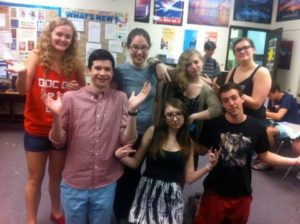
The Evanstonian is a space where students can escape academic monotony in the presence of others who share a common interest. To that effect, specific moments from the Evanstonian have stuck with the past Executive Editors beyond their years at ETHS.
“One time, we were publishing a story about Willie the Wildkit. We didn’t know who the student was, but, somehow, we needed a picture of them,” Hirsh says. “So I had to throw on the mascot outfit and do a photoshoot with myself as Willie the Wildkit, which was a lot of fun.”

Keren Joshi, one of the Evanstonian’s Executive Editors during the 1991-92 school year, reflects similar sentiments.
“We had an issue that was due the Sunday after Prom. Everybody showed up [to layout] exhausted the following morning. Dan Newberger, who was my co-Executive Editor, decided that it would be fun if we made everyone pancakes, so we brought in an electric griddle and batter and it will forever remain a [core] memory of mine,” Joshi shares.
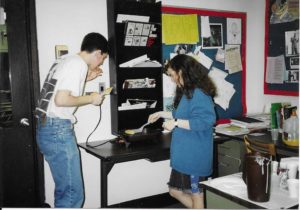
The cohesive culture of the community is most prominent during layout. This process is a puzzle and the Executive Editors make the pieces fit.
“Layout nights [for] the Evanstonian were always so much fun,” Baum says. “You get punchy and tired but everyone is working to [achieve] the same goal. One night, in particular, I remember I was at layout and it was the night we had to turn in the paper, and I got an email saying I got accepted into college. My Evanstonian colleagues were the first people to [find out] that I had gotten accepted into my dream school.”
The early 2010’s signified the poster years of Taylor Swift’s ascent to fame; these early soundtracks enhanced the staff’s productivity during strenuous times. This still remains true today–with over a dozen albums in 2023, Swift has grown alongside the publication.
“During layout, [Mr. Lowe] only allowed us to listen to Taylor Swift. It was 2012, so Fearless, Speak Now and Red had just come out. Mr. Lowe bought a copy of Red on CD from the Walgreens on Dodge because we were sick of listening to Fearless. We [would] listen to those three CD’s all night,” Schneider shares. “It was wild.”
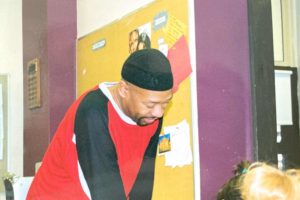
Rodney K. Lowe spent over three decades fostering a community of young journalists in his role as adviser to the Evanstonian. Mr. Lowe never failed to put his students first; the Executive Editors–and mentees of Lowe–continue to commemorate his legacy through remembrance and storytelling.
“Some of my fondest memories associated with Evanstonian were times spent in the office during a free period, brainstorming ideas and hanging out with Mr. Lowe,” Randhava says. “He was our advisor at the time, and he was a hugely influential figure for me, both in high school and beyond. Mr. Lowe was endlessly encouraging of anything folks wanted to pursue. He was just as excited when folks went into communications fields as he was when they pursued other opportunities. He helped students think about how they could apply what they were learning at the Evanstonian in their future endeavors.”
Mr. Lowe, the man who brought the Evanstonian to life for over 30 years, had a contagious energy which was felt by everyone he came into contact with.
Currently an English as a second language (ESL) teacher at a high school in Iowa City, Schneider tries to replicate the high-spirited environment that Mr. Lowe created when she was a student of his.
“I start the school year by talking about Mr. Lowe and all of the things he did in his classroom that I loved and respected. I straight up tell my [students] that I am going to try to capture some of Mr. Lowe’s teaching style–the difficult learning with lots of fun and a really close knit [community].” Schneider continues, “I don’t do it perfectly, but I try to be as good as Mr. Lowe every day. I really do.”
During her involvement with the Evanstonian, Schneider had the opportunity to give high school students feedback on their writing and engage with school policies from a young age. This has served Schneider well in her current role, as she advocates for a vulnerable population within her school.
Being an instrumental part of the Evanstonian has had a considerable impact on the past Executive Editors, both in their personal and professional lives. Productively learning from the experiences of the past Executive Editors can help the current staff identify areas for growth and inherit wisdom.
“Find stories that you’re interested in and that you think [the student body] would be interested in and just go for it,” Hirsh says. “Don’t be afraid to make mistakes, because you’ll learn from those mistakes. Take it as a responsibility that students at the school may not have another outlet to express their opinions or share their stories and ideas. If you’re a member of the [Evanstonian] staff, you’re a voice to all [of the] students in the school. You have a responsibility to make sure all voices are heard.”


